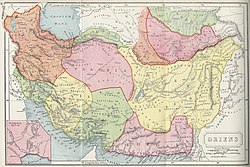
Back Ariane (Pers) Breton Ariana Catalan Ariana (Region) German Αριανή Greek Ariana (región) Spanish آریانا Persian Ariana ID Ariana (kraina historyczna) Polish آریانا (علاقہ) PNB آريانا Pashto/Pushto
Ariana
Ἀρ(ε)ιανή | |
|---|---|
District | |
 The Atlas of Ancient and Classical Geography by Samuel Butler and Ernest Rhys, showing Ariana in the east (yellow) based on Eratosthenes descriptions. | |
| Country | Modern day Afghanistan, parts of Modern day Iran, and western Pakistan |
| Empire | Achaemenid |
Ariana was a general geographical term used by some Greek and Roman authors of the ancient period for a district of wide extent between Central Asia[1] and the Indus River,[2] comprising the eastern provinces of the Achaemenid Empire[3] that covered the whole of modern-day Afghanistan, as well as the easternmost part of Iran and up to the Indus River in Pakistan.[4][5] Ariana is the Latinized form of the Ancient Greek Ἀρ(ε)ιανή Ar(e)ianē (inhabitants: Ariani; Ἀρ(ε)ιανοί Ar(e)ianoi),[6] originating from the Old Persian word Ariyanem (Ariana) meaning 'the Land of the Aryans', similar to the use of Āryāvarta.
At various times, various parts of the region were governed by the Persians (the Achaemenids from 550 to 330 BC, the Sasanians from 275 to 650 AD and the Kushano-Sasanians from 345 to 450 AD), the Macedonians, the Seleucids from 330 to 305 BC, the Maurya Empire from 305 BC to 184 BC, then the Greco-Bactrians from and the Indo-Greeks from 155 to 90 BC, the Indo-Scythians from 90 BC to 20 AD, the Parthians from 160 BC to 225 AD including the Indo-Parthians from 20 to 225 AD and the Kushans from 110 BC to 225 AD, the Xionites (the Kidarites from 360 to 465 AD and the Hephthalites from 450 to 565 AD) and various other Huna peoples.
- ^ Smith, William (1980). "Ariana". Dictionary of Greek and Roman Geography. Boston: Little, Brown, and Co. pp. 210–211. Retrieved 2013-05-10.
- ^ Schmitt, R. (1986). "Aria". Encyclopaedia Iranica. Retrieved 2013-05-10.
- ^ Lewis, Charlton T.; Short, Charles. "Ărĭāna". A Latin Dictionary. Perseus Digital Library. Retrieved 2013-05-10.
- ^ The Columbia Encyclopedia, Sixth Edition, 2008
- ^ Sagar, Krishna Chandra (1 January 1992). Foreign Influence on Ancient India. Northern Book Centre. p. 91. ISBN 9788172110284.
According to Strabo (c. 54 B.C., A.D. 24), who refers to the authority of Apollodorus of Artemia, the Greeks of Bactria became masters of Ariana, a vague term roughly indicating the eastern districts of the Persian empire, and of India.
- ^ Pliny, Naturalis Historia, book vi, page 23
© MMXXIII Rich X Search. We shall prevail. All rights reserved. Rich X Search